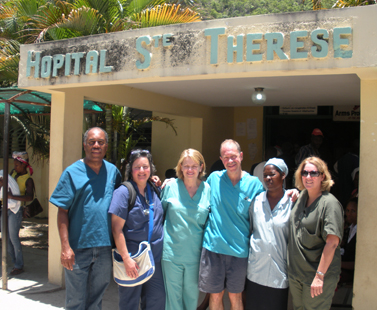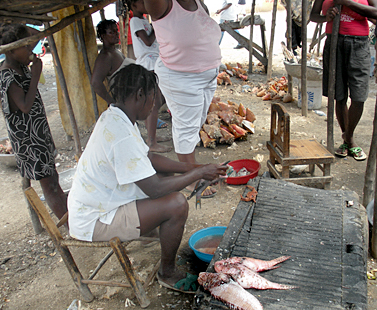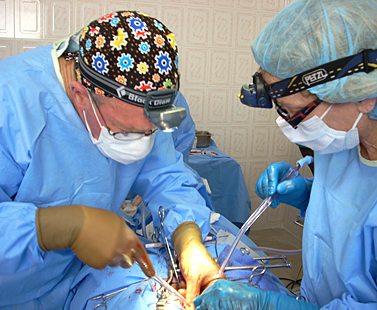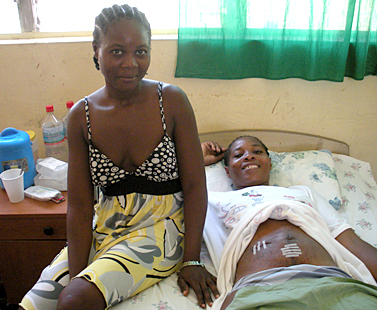Helping in the face of devastation: USF doctor visits Haiti
The tiny hospital was only 60 miles from Port-au-Prince, but it took four hours for Dr. Mitch Hoffman to get there over the traffic-packed, earthquake-torn roads.
It took only a few minutes to get the first cry for help.
Something was terribly wrong in the delivery room.
Dr. Hoffman, director of the USF gynecology oncology division, and Dr. Kathleen Kilbride, a colleague of 29 years, ran to the delivering mother to discover that the situation was dire. As the baby began to move through the birth canal, the shoulder had gotten stuck inside.
Shoulder dystocia is one of the most feared emergencies in obstetrics. It usually happens without warning. Obstetricians run practice drills on techniques to unblock the baby’s shoulder. As a last resort, they may break the baby’s collarbone or even push the baby back inside for an emergency Caesarean.
Without skilled help, the baby can suffer brain damage or die.
They didn’t want that to happen here. Tampa Ob/Gyn Dr. Kathleen Kilbride performed an episiotomy and began manipulating the baby. They directed a nurse to move the mother’s legs in a maneuver known to ease pressure on the baby’s shoulder. Dr. Hoffman worked on the other side, pushing on the mother’s belly to free the baby’s shoulder.
It worked. The baby was delivered safely. A few hours earlier, and that wouldn’t have happened. Drs. Hoffman and Kilbride knew that if they hadn’t been there, the baby would have died.

Dr. Hoffman set out to help in Haiti after January’s devastating earthquake after hearing stories from other doctors and his own daughter Emily, who had volunteered in Haiti several times over the years. He returned to Tampa last month after a six-day stay on the nation’s southern peninsula.
While Dr. Hoffman knows the team saved lives while there, he was blunt about his overall impact. Haiti’s health problems, he said, are staggering. They require more than a visiting doctor, or even a team of visiting doctors.
“The kind of help I have isn’t what they really need,” he said. “Their needs are at the most basic level. It’s sprawling, abject poverty.”
The sheer magnitude of the public health needs, the organization required to provide safe water and food and hygiene, is overwhelming.
***
Dr. Hoffman’s trip to Haiti was organized through two non-profit groups, Help Brings Hope for Haiti and Haiti Help Med. Various groups helped provide supplies for the trip as well.
The group focused their efforts on the northern coast of Haiti’s southern peninsula, at a rural hospital in the village of Miragoane. They made a side trip to another village, Paillant. Haiti Help Med is building a new operating room and dental clinic addition at a small hospital there, as well as working to improve health and living conditions throughout the region.
Dr. Hoffman found himself admiring the beauty of Haiti’s mountains and beaches.
“It’s beautiful country,” he said. “That’s part of the untold story. Parts of it are breathtaking.”
Yet that beauty is marred not only by the devastation of this year’s earthquake, but also by the scars of poverty. Dr. Hoffman shot beautiful photos walking on the beach at sunset.
Just outside the photo’s borders, mounds of trash sprawl on the shore. Another photo shows the busy local fish market, stocked from local waters. What doesn’t show here: since vendors didn’t have any refrigeration, the market soon reeked of rotting fish.

The team was advised before the trip that they would need to bring all medical supplies they needed with them. Even so, Dr. Hoffman said, it’s hard to realize just how few supplies were available. Patients didn’t receive IV fluids and pain medicines unless family members could supply them.
At one point, the team was treating a woman who was hemorrhaging from an ectopic pregnancy. At first, they were told no blood was available. Then two bags of blood were located. A nurse insisted it was the correct type.
Dr. Hoffman and the team members had no choice.
“This lady was dying quickly,” he said. “We weren’t sure the blood was safe, but we had to give it to her.”
Once again, fortune was on their side, and the patient survived.
But for many patients, the odds are long. Drs. Kilbride and Hoffman delivered a 29-week-old premature baby girl who then shared an incubator with another baby. In the U.S., the girl would most likely survive — about 90 percent of such babies do.
But here, born too young to have developed a good sucking and swallowing reflex, the girl’s chances were iffy. Dr. Hoffman was told that she was likely to die.
Other patients faced steep odds as well. For all the injuries and health problems caused by the earthquake, Dr. Hoffman knew that Haitian women already cope with poor health conditions. Pregnant women have high rates of such complications as hemorrhage, infection, and preeclampsia. Only about one in four births are attended by skilled healthcare workers.
For every 100,000 babies born, 670 Haitian women die — compared to just 11 in the U.S. A child born in Haiti is ten times more likely to die before his fifth birthday than a child born in the U.S.
***
When the team arrived, they discovered that the anesthesia equipment was in such bad repair that their anesthesiologist deemed it unsafe to use. They had to perform all their surgeries with spinal pain medication rather than general anesthesia.
While Dr. Hoffman was there, he saw Haitian nurses, but no doctors, available to care for patients. Two Cuban doctors were staying at Miragoane to help as well.

After an operation, Haitian nurses ordered patients to stay in bed — just the opposite of today’s medical standards in the U.S.
“We would get them up and walk the patients ourselves,” Dr. Hoffman said.
Privacy was nonexistent. Many patients lay in bed naked. Sanitary conditions were bad; it was hot, flies crawled everywhere, there was no running water or bathroom facilities, and patients had to rely on family members to help them use bedpans and dispose of waste.
At first, conditions and differences led to frustration with the Haitian nurses. Over time, team members realized that the staff members faced difficulties as well. They got paid irregularly and often worked hungry.
Despite such conditions, there were successes. Dr. Hoffman and Dr. Kilbride, a USF College of Medicine graduate who was a resident with Dr. Hoffman, worked smoothly as a team. The anesthesiologist, Lilian Pereiras, repeatedly performed flawless spinal anesthesia and worked tirelessly to keep the patients comfortable. The operating room nurse, Karen Carraher, kept everything and everyone organized and running smoothly. The leader of Haiti Help Med, Dr. Ralph Gousse, and his wife Ninotte, met constantly with community members and oversaw various projects.

Dr. Hoffman was asked before he made the trip if he could operate on one particular patient. This woman had to have a colostomy months earlier, when her bowel was injured after a miscarriage. Dr. Hoffman and Dr. Kilbride were able to remove the colostomy, repair her bowel, and help her recover from surgery.
The team found another patient in the hospital who had delivered a stillborn baby a day earlier. She was slipping close to death: she had had seizures and she couldn’t see. She could barely move, and her blood pressure had skyrocketed. Nobody had diagnosed what was wrong.
But Drs. Hoffman and Kilbride thought they knew. The woman had developed eclampsia and was suffering from PRES Syndrome, a brain swelling that can be fatal if left untreated. They began treatments to lower her blood pressure and she recovered.

Dr. Hoffman is already planning what he will do differently if he returns to Haiti in the fall. He would bring more equipment. He might work out of Paillant, where Haiti Help Med is building its new operating room. He would spend more time training others. He would try to bring someone who speaks Creole, but would love to work again with the same team.
— Story by Lisa Greene, USF Health Communications; photos courtesy of Dr. Mitch Hoffman
PUTTING IT ALL TOGETHER: HELPING IN HAITI
Haiti Help Med, one of the groups that helped organize the trip to Haiti, is led by a Haitian-born medical oncologist from Orlando, Dr. Ralph Gousse, and his colleague, Henri Jabon.
Dr. Gousse was part of the team that Dr. Hoffman joined to go to Haiti. The team also included Dr. Kathleen Kilbride, a USF College of Medicine graduate who was a resident with Dr. Hoffman; Lilian Pereira, an anesthesiologist from Tennesse; Karen Carraher, the nursing director of a St. Petersburg outpatient surgery center; and Ninotte Gousse, Dr. Gousse’s wife.
The team and the supplies it needed were organized by Hillary Aubin and Patricia Eddy through their organization Help Brings Hope for Haiti. Eddy chairs the group, which concentrates on education, supplies and sustainable food and water sources for a region of northeastern Haiti. Aubin flew with a large amount of donated supplies and ensured their delivery in advance of the team’s arrival.
“I was so lucky to wind up working with such a great team,” said Dr. Hoffman said.
He had praise for the entire group: Dr. Kilbride’s obstetric skill and “big heart;” Dr. Pereira’s “brilliant” anesthesia work; Carraher’s “wonderful deameanor and organizational skills;” and Ninotte Gousse’s empathy and talent for nurturing others.
Dr. Hoffman was especially impressed with Dr. Gousse’s efforts to improve health and living standards throughout the region with Haiti Help Med.
“He shows incredible leadership and vision for this community,” Dr. Hoffman said.

